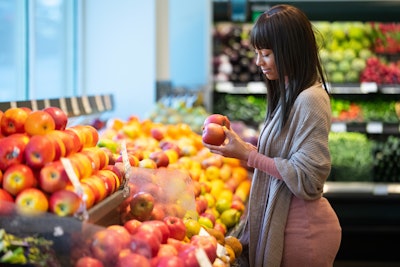
Since childhood, we’ve been taught that eating fruits and vegetables is the cornerstone of a healthy lifestyle. Today, that lesson is a leading trend with consumers. Over the last decade, there has been a 500% increase in U.S. adults adopting a plant-based diet.
Whether the recent spike in popularity is due to increasing environmental concerns, personal wellness goals or something else, people are consuming more whole foods in their daily diet than ever. But before shoppers can pick up the abundance of plant-based items needed for a balanced diet and bring them home, produce must first survive the journey and the many factors that threaten its quality and shelf life.
Considering produce begins to deteriorate at the moment of harvest, the process of moving fruits and vegetables at the peak of freshness from farm to store shelves safely and timely involves a number of transportation logistics challenges. To meet intense deadlines and navigate ongoing supply chain disruptions, it’s crucial to partner with an experienced premier logistics partner. An experienced logistics partner has access to the best transportation methods and understands the constraints and what to prioritize when moving produce to get food on the table, no matter what challenges arise.
Here are three of the greatest threats to transporting fresh produce and how to overcome them:
1. Controlling temperatures
Produce is harvested, cooled and prepared for shipment daily. Logistics partners need to understand this process fully in order to have their equipment onsite and properly pre-cooled for the specific product they are handling. The fragile nature of fruits and vegetables makes maintaining the proper temperature a critical element of the cold chain.
Each shipment contains products that have similar temperature requirements. Since products ship at a variety of temperatures and humidity levels, produce transport can’t be a one-size-fits-all operation. A deviation of just a few degrees can spoil product, resulting in empty shelves and financial losses.
The ability to effectively track and analyze temperature data throughout product transport enables shippers and logistics providers to ensure the quality of the produce during transportation. An experienced logistics partner utilizes the latest technological systems and relies on a monitoring and logging process which enables them to make adjustments throughout transport to preserve the integrity of the product and avoid costly losses at delivery.
The right third-party logistics (3PL) partner provides more than just a truck and trailer or trucking brokerage services to move product. Their experienced team will know the specific requirements needed, based on the product, to move each load safely. Those requirements and all relevant information for loading and delivery will be clearly communicated to their pre-vetted drivers who have that same product knowledge. Together, the drivers and logistics operations team will work in concert to meet those needs and make adjustments throughout transport.
Maintaining the right temperature throughout the supply chain journey does more than keep food safe and fresh, it also preserves its appearance. While this may sound trivial, consumers make produce purchases based on appearance and consistently choose products that look and feel fresh. This results in 30% of food being thrown out due to undesirable appearance which results in increased food waste and lost sales for stores. Properly transporting and storing fruits and vegetables, keeping them free of bacteria growth and other damage, is a reliable way to keep temperature-sensitive freight in the right condition and ensuring it makes it into the hands of consumers.
2. Regulatory requirements
Perishable produce must meet a range of rules and regulations, including FSMA’s Produce Safety Rule, which establishes science-based minimum standards for safe packaging and storing of fruits and vegetables grown for human consumption. While this rule covers the entire supply chain, the primary responsibility for maintaining safe, sanitary produce lies with shippers and carriers. Aside from product-specific temperature requirements, the design and maintenance of vehicles and equipment must also be compliant.
Providing suitable temperature regulated transportation equipment includes removing broken shipping pallets that may damage packaging, having cleanable surfaces and ensuring there is no corrosion or flaking. Trucks must be given adequate time to cool before taking new loads and cleaned after every delivery. Additionally, with 32 million Americans experiencing food allergies and cross-contamination is another necessary precaution for carriers to take when loading, storing and unloading produce intended for consumption.
A premier logistics partner will have procedures in place to ensure food safety and responsibility. They partner only with trusted carriers who know the ins and outs of food safety regulations and prioritize clean, functioning and safe equipment.
3. Information sharing
Given that only 6% of companies claim to have full supply chain visibility, lack of data sharing among cold chain stakeholders is a significant challenge when shipping temperature-sensitive food. Successful capacity planning, demand forecasting and optimal transportation route planning all heavily rely on real-time data insights. Without proper information, it is impossible to make fast-paced, accurate decisions. The FDA recently announced that by 2026, stakeholders must keep records for critical tracking events (CTEs) in the supply chain for foods on the Food Traceability List (FTL), which includes several fresh produce items. Sharing among cold chain stakeholders won't just be beneficial, but failing to do so will be considered non-compliant.
The clock on fresh produce’s shelf life does not stop ticking if a truck breaks down. In an emergency situation where cold chain products must be moved onto a dry cross dock, it is pivotal to have an established cross-country network of carriers available to step in and take over before spoilage occurs. With real-time alerts, a notification can be sent to stakeholders to allow prompt action.
Temperature fluctuations, strict regulatory requirements and lack of data and tracking visibility all contribute to the 1.4 billion tons of food wasted every year. A dependable logistics partner that offers 24/7 tracking is key to remaining competitive in the food industry, building customer trust, and meeting high throughput times for a wide variety of peak produce. Passionate and experienced 3PL providers will offer full transparency, providing pickup and delivery status and communicating at every point to share exactly where the freight is.
The right partner
Through emerging food trends, new rules and regulations or supply chain disruptions, logistics professionals play a key role in keeping consumers safe and putting meals on the table for Americans from coast to coast and beyond. Moving fresh produce in a high-paced market is a complex challenge that requires seamless and simultaneous functioning across the entire supply chain to ensure perishable freight reaches its destination in optimal condition. With the help of a reliable logistics partner, shoppers never have to miss out on their favorite produce.




















